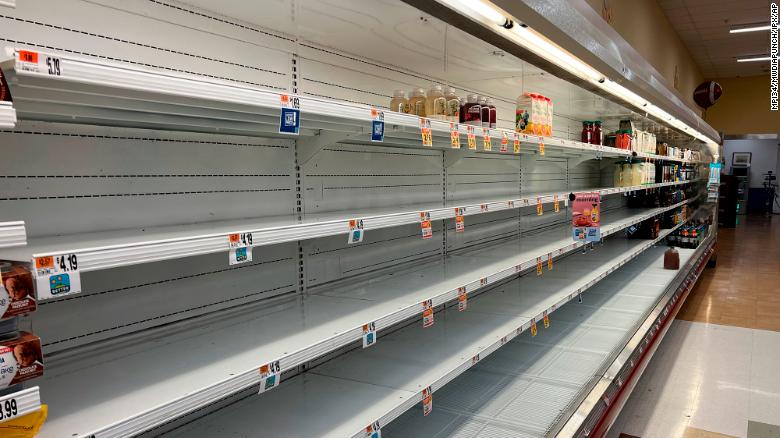Shopping at the supermarket will not be cheap in 2022 0:55
New York (CNN Business) -
Supermarket shelves across the United States are empty, and will continue to be, as stores scramble to quickly replenish necessities like milk, bread, meat, canned soups and produce. cleaning.
Disgruntled shoppers have unleashed their frustration on social media in recent days, posting photos on Twitter of empty shelves at Trader Joe's, Giant Foods and Publix stores, among many others.
After dealing with a two-year pandemic and supply chain issues, supermarkets still didn't get the respite they hoped for.
Rather, they now face a host of other setbacks.
Omicron's devastating blow
As the highly contagious omicron variant of the coronavirus continues to make workers sick, it is creating staff shortages for critical functions such as transportation and logistics, which in turn is affecting product delivery and restocking of store shelves. in all the country.
Albertsons CEO Vivek Sankaran acknowledged that product supply is tight during the company's earnings call with analysts on Tuesday.
"I think that as a company, we have all learned to manage it. We have all learned to make sure that the stores remain very presentable, and to give consumers as many options as we can," Sankaran said during the call.
advertising
Still, he added, omicron has made "a bit of a dent" in efforts to improve supply chain deficiencies.
"We expect there to be more supply problems in the next four to six weeks," Sankaran said.
The United States reports sick: the latest wave of covid-19, driven by the omicron variant, affects businesses
Supermarkets are operating with fewer employees than normal, according to the National Grocery Store Association, and many of their members have less than 50% of their normal workforce.
Empty shelves for the weekend at a Trader Joe's grocery store on Spring Street, New York.
"Although there is a lot of food in the supply chain, we anticipate that consumers will continue to experience sporadic disruptions in certain product categories, as we have seen in the last year and a half, due to ongoing supply and staffing issues," said Greg Ferrara , president and CEO of the group.
In fact, staff shortages continue to pressure all areas of the food industry, according to Phil Lempert, industry analyst and editor at SuperMarketGuru.com.
"From farms to food manufacturers to grocery stores, it's widespread," Lempert said.
"During the pandemic, these operations have had to implement distancing protocols and they are not designed for that and it has impacted on production."
And as the pandemic continues, many food industry workers are choosing not to return to their low-wage jobs.
The United States added just 199,000 jobs in December, the lowest number in all of 2021
Transportation problems
The continuing shortage of truckers continues to hamper the supply chain and supermarkets' ability to restock their shelves quickly.
Empty shelves over the weekend at a Giant Foods supermarket in Alexandria, Virginia.
"The trucking industry has an aging workforce as well as a shortage," Lempert said.
"It really has been a problem for the past few years."
Added to the generalized problems of national transportation is the record level of congestion in the country's ports.
"Both problems combine to create shortages," he said.
Weather problems
At Trader Joe's stores, shoppers saw messages taped to empty shelves over the weekend blaming weather emergencies for late deliveries.
Much of the Midwest and Northeast have recently suffered from inclement weather and dangerous road conditions.
Not only are people stocking up on more food, but high demand, coupled with transportation problems, is making it difficult to transport goods in bad weather, leading to further shortages, Lempert said.
Not to mention climate change, which is a serious and long-term threat to the food supply.
"The fires and droughts are damaging crops like wheat, corn and soybeans in the United States and coffee crops in Brazil," he said.
"We can't ignore it."
The pandemic changed our eating habits
More and more of us are cooking and eating at home because of the pandemic, which also contributes to food shortages, Lempert said.
"We don't want to keep eating the same thing and we are trying to vary the homemade food. By doing so, we are buying even more products," he said.
Shortages have also made food purchases increasingly expensive heading into 2022.
Supermarkets are certainly aware of empty shelves, Lempert said, and are trying to mitigate panic buying, which only makes the situation worse.
One strategy: distribute the products.
They do this by selling both varieties and limited quantities of each product, in an attempt to avoid hoarding and to stretch their supplies between deliveries.
"Before the pandemic you saw five different varieties of milk in the first row and 10 cartons deep. Now there will be five in the entire row and maybe two rows deep," Lempert said.
- CNN's Nathaniel Meyersohn and Danielle Wiener-Bronner contributed to this report.
supply chain Supermarkets

